Description:
Lucien Hector Monod (1867-1957) was a French painter and lithographer. His work was derived from the symbolism movement. He painted in the Art Nouveau style and the 18th century French Rococo. He studied at the Académie Julian in Paris*. His works are characterized by capturing unique colors, especially shaded parts, long hours of observation of nature and impressive decorative depictions. Monod saw and captured the uniqueness and poeticism of the everyday life that was no longer noticed. He was a popular artist, often subordinating the theme of his works to the tastes of the public***.
Description of the painting:
“Swans” shows a profile of a woman against a small pond surrounded by vegetation. It is contrasted by the swans swimming in it, painted on the right side of the painting. The woman holds a blue lotus flower in her hand. The characteristic slender, curved neck of the woman, the way the fabric of her dress is shown and the plant she holds belong to the water world, making both, seemingly different, images connected by subtle similarities. The symbolism portrayed in the painting emphasizes the stunning beauty of women, the purity and grace of their nature, and the
On the painting is captured a figure of a young woman standing by a pond, bathed in the spectacular play of sunlight filtering through the crowns of the surrounding trees. Two swans are floating in the water. The woman is dressed in a blue and white, visually vibrating, highly ornamental long dress. In her left hand she holds a blue comb, called the Blue Lotus ‘Nymphaea nouchali’. She bows her head towards it and yields to the sensuous aroma emanating from it. Her eyes, veiled by her eyelids, allow her to completely submerge into the world of senses.
In Ancient symbolism, the comb, the blue lotus, symbolized purity and a spirit that rises above sinful worldly life. It was a symbol of the spirit’s victory over matter, of light over darkness. The mystery and mystic connection between the past, the present and the future was seen in the lotus flowers, as they simultaneously contained buds, flowers and fruits. In China, they stand for continuity, marriage, offspring, happiness and female beauty.
The white swan is interpreted as the symbol of corporeality and spirituality. It becomes an emblem of grace, purity and immortality. In Scandinavia, Arabia, Persia, India and Slavic countries, swans are mainly associated with the female element. It is a representation of beauty and virginity. In Germanic beliefs, virgins-prophets are believed to transform into swans. Greek myths mention the involvement of Apollo in granting swans the ability to predict the future. It is believed that Aphrodite’s chariot was drawn by swans. Zeus seduced Leda in the form of a swan, and the Trojan Helen was born from this union. The combination of the lotus flower and the white swan in Eastern beliefs and symbolism becomes a symbol of the Annunciation, which corresponds to the combination of a dove and a lily in Western countries.
The water in the background can be interpreted as the mirror of the soul. The calm and controlled water of the pond was believed to restore youth and life. It is called the noblest of the elements and nature itself originates from it. It is necessary for survival. It is often associated with instability, change and rebirth. The mirror of water was supposed to be a mirror, reflecting not only the physical appearance but also the character of the person looking into it.
The work of Lucien Hector Monod refers to mythology, antiquity, the border between European and Eastern culture. It uses the symbolism taken from it to show the essence of femininity.


